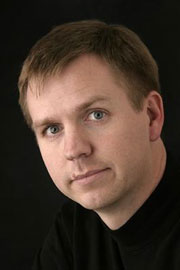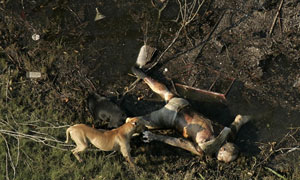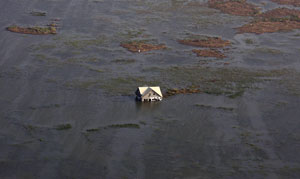 |
 | |||||||||||||
KATRINA AFTERMATH:
"So this is what 'The Big One' looks like" |
 |
||||||||||||
|
For as far back as I can remember, the word "hurricane" was among the most ominous in the vocabulary. That's how it is when you are born in Galveston and spend most of your life living on the Texas Gulf Coast.
Growing up, summers were spent with hurricane kits prepared, evacuation routes planned and each storm's progress was tracked on paper charts that came in the newspaper (except at my grandmother's house where she had a really cool chart made of metal with magnets to trace the storm's progress).
For my professional life, covering storms had become somewhat routine as well. Each started with the same trip to the store. The same supplies were piled into the vehicle. Similar patterns of deployment followed. Then came the familiar chase up and down the coast ending with the same scramble to find shelter in whatever town was in the crosshairs of the storm.
After moving from Houston to Dallas two years ago, my wife and I even noticed and remarked on the absence of the very present storm threat. Not that we missed it, mind you, but we did notice something different in our lives.
No one whose family has lived for a long time along the coast has escaped the effects of these seasonal storms. Depending on where you live, the storms are household names.
For our region, the 1900 storm that wiped out Galveston has always been the biggest of them all. It was a storm so vicious that little of the city remained and at least 6,000 people were killed. Growing up, I was always spellbound by the photographs and accounts of that storm.
In my family Hurricane Carla, in 1961, was always the big one. I grew up riveted by the tales of how she came ashore five years before I was born and took away my grandmother's house, leaving only a bathtub for identification.
Personally, Allison, not even a hurricane but a tropical storm, held the most weight. She flooded Houston so severely one night in 2001 that I merely waded off my front porch into chest-deep water to cover that storm. All of the photographs I made were within a few blocks of my house. Many of our friends and neighbors had flooded homes and it took years for them to finally rebuild. The storm left 22 dead and $5 billion in damage. A great many of the dead perished within a few miles of my house.
Allison's waters stopped right at our front door, but I remember thinking that the roof was the only option for my wife and visiting mother-in-law had the water not stopped rising.
It was against this backdrop of ample fear and respect that I was dispatched in advance of Hurricane Katrina to cover what was about to become the storm of the century.
I drove all night to get to a friend's home in St. Martinville, La. (just outside of Lafayette). They were gracious enough to take me in. I was an addition to over a dozen displaced friends from New Orleans who had evacuated to their house. Adults, children and pets were everywhere - and most still are.
We all sat glued to television accounts as the storm came ashore. The evacuated hungered for any news of their homes. I worried with them, all the while trying to calculate my next move.
With all the helicopters evacuated well out of range of the storm, that proved impossible, so I spent the first day of the "storm of the century" high and dry in Lafayette, frustrated and wondering, like my evacuated friends and most of America, what was actually happening in New Orleans.
With no aircraft available for hire, it was finally decided that our normal charter service from Dallas would have to fly in and meet me in Lafayette the next morning. Since we had one of the precious few helicopters to be found, we offered to share our ride with The Associated Press.
So at 6:30 a.m. on the morning after the storm, with AP photographer David J. Phillip and pilot Ken Pyatt, we took off from Lafayette.
How wrong I was to think I was prepared for Katrina.
Army, Navy, Air Force, Marines! Isn't that how the old recruiting slogan always went? Katrina's effects required all branches to cover as well. While my unfortunate and dedicated colleagues slogged it out on the ground and in the water, I was high and dry hundreds of feet above the mess that was now New Orleans and the Mississippi coast. I became the photojournalism equivalent of the Air Force.
The inherent dangers of flying in a small helicopter and the long hours involved notwithstanding, I must admit I had a pretty cushy assignment compared to all those souls on the ground.
That first morning, the skies over the city were eerily quiet as the major air operations were yet to begin. Our veteran pilot found it pretty unnerving to be flying over a major American city with no air traffic control and no traffic on the radio. We were all overwhelmed by the devastation.
It was obvious from the first moments over New Orleans that this was no ordinary storm. The devastation was incredible. I've covered many different storms and Katrina made them all look minor.
By the afternoon, a military AWACS plane was handling air traffic, and things were hopping with rescue helicopters thick over the city. By the next morning, the FAA had shut our flight operations down - having declared one TV helicopter the sole "pool" helicopter for the area.
That's when the AP stepped in to correct the oversight with the FAA in Washington, and our helicopter was declared the still photo pool helicopter for New Orleans for the duration. So began our mission that lasted for two weeks. It was a system that we repeated for Hurricane Rita as well.
This presented some challenges in getting out to the far reaches of the storm's path, but it also meant that we would be filing photos on a regular schedule. Since we had to come out of the affected areas for fuel, it also meant that our power and communications challenges were relatively minor.
Every day ended back in Lafayette where I would make my way "home" to my friend's house and give the nightly report to our group of worried evacuees.
"Be prepared to have lost everything." That is how I prefaced the first nightly report to my evacuated New Orleans friends as they gathered around my laptop for a slide show of images from the devastation I had shot from a helicopter that day. I didn't want to be too dramatic, but I also thought they should be ready to see how bad the damage really was. Katrina was not a storm that could be sugar-coated.
Shooting aerial photographs is by nature a very impersonal endeavor. Filing those photos is impersonal as well. You hit a button and the photo is gone. Rarely do you get a sense of the reaction people will have when the see them. I wasn't prepared for the very personal reaction of having my friends see what had become of their city.
As the images flashed by I could tell that my assessment had hit pretty close to the mark. Gasps of, "Oh, My God," were followed by tense silence as one by one images of the flooded city came up on the screen.
Entire neighborhoods were covered to the rooftops. People clung to those rooftops desperate for rescue. From the air, the camera captured the massive scale of the devastation.
There were flashes of hope as well: witnessing people by the hundreds being rescued by helicopters and boats. Yet the most important photo I might have made that day was found in the fuzzy low-resolution blow-up from a wide-angle photograph that clearly showed my friend Chris Poche's house undamaged and dry, as were those of his neighbors who were likewise gathered around the screen.
It was a strange and powerful moment, to see how the photographs could cause so much pain, hope, understanding and relief in just a few moments to a group of weary New Orleans evacuees.
I thought back to all those historic photos from the 1900 Galveston storm that have long captivated me. After seeing Katrina's wrath, those photos became very real and I found an even deeper appreciation for what those photographers accomplished over a century ago.
As I would spend the next days photographing the damage caused by Katrina, I couldn't get the photos from 1900 out of my head. I kept thinking, "So this is what 'The Big One' looks like."
The photos from Katrina that we are producing now - as a profession - form the same type of historic document. That is a humbling thought and a huge responsibility. How fortunate we are to live in a time where we can shoot those photos from hovering helicopters and instantly transmit those photos to the world.
And how striking it is to see how all our technology and civilization could break down to nothing for those poor people stuck on the ground, in the Superdome and in the rising floodwaters. That fact became shockingly clear a few days later.
"The most horrible photograph I've made in my career." That was my answer to the simple question, "What did you see today?" asked by my wife in one of our precious and brief phone conversations during the aftermath of Katrina. The phone fell silent.
It took me two more days before I could bring myself to tell her what I'd seen. I still haven't shown her the photograph. I never showed it to my Louisiana friends either.
I've seen too many sad, horrific and sobering things in the course of my career. More times than I can remember I've been moved to tears. Sitting in the back seat of that helicopter after photographing dogs feeding on a human corpse in New Orleans, I was moved to prayer.
I took a deep breath, closed my eyes, and silently asked forgiveness for having taken the photograph. I asked that peace come to the soul of the man whose remains had floated to that single dry spot of land. I asked for comfort to come to his family. I asked that the dogs find safety. I asked that comfort and strength guide the rescue workers as they continued tirelessly to pull more and more of the living from those floodwaters.
Finally, I asked for strength that we all remain grateful and that we cherish the blessing of life that has been given to everyone who survived Katrina.
© Smiley N. Pool
Dispatches are brought to you by Canon. Send Canon a message of thanks. |
|||||||||||||
Back to October 2005 Contents
|
|




